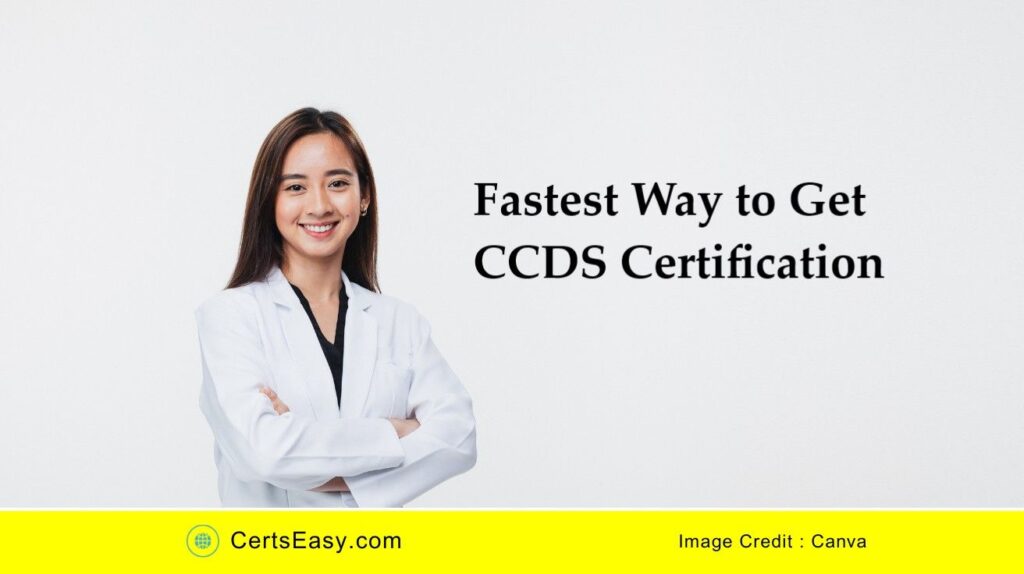If you want to build your career in healthcare and become a Certified Clinical Documentation Specialist (CCDS), you’re making one of the best career moves in 2025. When it comes to medical staffing, CCDS certification has its own strong reputation – it offers access to competitive salaries, high demand in the healthcare industry, and numerous opportunities for career growth.

We aim to provide insights on how you can access free voucher opportunities and the essential study materials needed for self-preparation. Wishing you all the best in your career growth and your journey toward CCDS certification.
Table of Contents
Why Medical Professionals Want to Get CCDS Certified in 2025
As discussed earlier in the introduction, people are often drawn to high salaries, easy career growth, and job security. Additionally, free voucher opportunities can also be a motivating factor.
✅ Higher Salary : In countries like the USA, CCDS-certified professionals (including RNs) can earn between $70,000 and $100,000+ annually.
✅ Career Growth : Hospitals, recruiters, and staffing agencies prioritize CCDS certified candidates for Clinical Documentation Improvement (CDI) roles.
✅ Job Security : With growing regulatory demands, CCDS experts are in high demand across the competitive healthcare job market.
✅ Free Voucher Opportunities : Some employers and training programs offer CCDS exam fee vouchers, giving you a chance to earn your CCDS certification at no cost just grab the opportunity and go for it!
CCDS Certification Course Module
Before starting the CCDS certification, it’s important to understand the CCDS course syllabus. This will help you know where to begin your preparation and how much time and effort to allocate to each section.
| Section | Key Topics | No of Questions | Focus Areas | Examples/Notes |
|---|---|---|---|---|
| I. Healthcare Regulations & IPPS | IPPS, MS-DRGs, CMS Rules, Auditors | 15 (10R, 3A, 2An) | – IPPS updates – Two-Midnight Rule – CC/MCC impact on DRGs – Medicare contractors (RA, MAC, OIG) | MS-DRG = Base + (MCC/CC modifiers) |
| II. Anatomy/Pathophysiology | Major MDCs, Clinical Indicators, Pharmacology | 23 (12A, 11An) | – Link drugs to conditions (e.g., heparin → PE) – Labs/imaging as indicators – MDC-specific diagnoses (e.g., sepsis in MDC 18) | COPD exacerbation = MDC 4 |
| III. Medical Documentation | Physician Queries, Compliant Documentation | 23 (6R, 11A, 6An) | – Query types (open-ended vs. leading) – Clinical indicators – AHIMA/ACDIS query guidelines | Non-compliant query: “Is the patient in septic shock?” |
| IV. CDI Program Analysis | Metrics, PEPPER, Financial Impact | 10 (3R, 4A, 3An) | – CMI trends – CC/MCC capture rate – PSI 90 components | PEPPER = Targets over-/under-coding |
| V. Communication Skills | Physician Education, DRG Reconciliation | 11 (3R, 6A, 2An) | – Effective query phrasing – Dispute resolution – Verbal vs. written communication | Use data to justify queries (e.g., “Lactate 4.0 supports sepsis”) |
| VI. Coding Guidelines | Principal Dx, POA, HACs, AHA Coding Clinic | 17 (6R, 8A, 3An) | – POA rules – Hospital-acquired conditions – Principal vs. secondary Dx | HACs: Never POA = “N” |
| VII. Ethics & Compliance | DRG Creep, Confidentiality, OIG Risks | 11 (4R, 4A, 3An) | – Leading queries – OIG work plan targets – Compliance initiatives | DRG creep = Upcoding without justification |
| VIII. Quality Impact | HVBP, Mortality, PSIs, HAIs | 10 (3R, 3A, 4An) | – PSI 90 (e.g., PSI 03/06) – 30-day readmissions – Observed/expected mortality | HVBP = 2% payment adjustment |
Certified Clinical Documentation Specialist (CCDS) Exam Cost
CCDS certification cost has two types. First one Standard Cost: $399 (for Association of Clinical Documentation Integrity Specialists (ACDIS) members) and second is $499 (for non ACDIS members).
How to Become an ACDIS Member?
Step 1. Choose Membership Type
- 1-Year Membership: $353
- 2-Year Membership: $518 (Better value)
Step 2. Purchase Options
- Online: Visit HCPro Store → Search “ACDIS Membership” → Add to cart.
- Phone: Call 800-650-6787 ext. 4111 (Renewals) or 615-724-7200 (New members).
Free Voucher Hack: Some employers, staffing agencies, or training programs cover exam fees – ask before paying!
CCDS Certification Exam Dumps
Question 1: Which of the following medications is commonly prescribed to stimulate appetite in patients with neoplasm or HIV-related cachexia?
A. Meridia®
B. Namenda®
C. Megace®
D. Synthroid®
Answer: C. Megace®
Explanation: Megace® (megestrol acetate) is an appetite stimulant frequently used to treat cachexia in cancer or HIV patients.
Question 2: It is important for the CDI specialist to discuss a concurrent query with the physician when…
- Only part of the query is answered
- There is conflicting documentation
- The physician documents a probable diagnosis
- The physician refuses to acknowledge or respond to the query
A. 1, 2, and 3 only
B. 1, 2, and 4 only
C. 1, 3, and 4 only
D. 2, 3, and 4 only
Answer: B. 1, 2, and 4 only
Explanation: A CDI specialist should follow up when:
- Only part of the query is answered (1),
- There is conflicting documentation (2), or
- The physician does not respond (4).
A “probable” diagnosis (3) may be acceptable if it meets clinical criteria, so immediate follow-up isn’t always necessary.
Question 3 : Aplastic anemia is a condition that:
A. Is hereditary and can only be sequenced as the principal diagnosis
B. Is defined as bone marrow failure causing a reduction in white blood cells, red blood cells, and platelets
C. Is chronic and easily treated
D. Qualifies as a major comorbid condition (MCC)
Answer: B
Explanation: Aplastic anemia is bone marrow failure causing pancytopenia (low RBCs, WBCs, and platelets). It is often acquired (not always hereditary), serious (not easily treated), and typically a CC, not an MCC.
Question 4 : A patient was admitted with shortness of breath, lower extremity swelling, severe weakness, elevated BNP (1,000), and EF=25%. Documentation includes history of heart failure and echocardiogram shows left ventricular dysfunction. What should the CDI specialist query for?
A. Combined diastolic and systolic heart failure
B. Congestive systolic heart failure
C. Acute and chronic systolic heart failure
D. Acute and chronic diastolic heart failure
Answer: C
Explanation:
- EF of 25% confirms systolic dysfunction (rules out purely diastolic options A/D)
- Elevated BNP + acute symptoms indicates acute exacerbation of chronic systolic HF (supported by patient history)
- “Congestive” (B) is outdated terminology and less specific
- Most accurate documentation would specify acute-on-chronic systolic HF to reflect both the baseline condition and current decompensation
Question 5 : When there is conflicting clinical documentation in the medical record, clarification must be provided by the _________.
A. Physician assistant
B. Consulting physician
C. Attending physician
D. Emergency physician
Answer: C
Explanation:
- The attending physician (C) has ultimate responsibility for the patient’s care and documentation accuracy.
- While other providers (A/B/D) may contribute to the record, only the attending physician can resolve conflicts in documentation.
- This aligns with Joint Commission standards and legal/regulatory requirements for medical record integrity.
CCDS Certification FAQs
Can I Get CCDS Certified Online?
Yes! The exam is proctored online (or at testing centers).
How Long Does CCDS Certification Validity?
3 years (renewal requires CEUs or retaking the exam). However cost of CCDS Certification renewal is differently charged.
CCDS Certification Eligibility?
A year of experience is defined as full-time employment or greater than 2,000 hours worked during that year.
